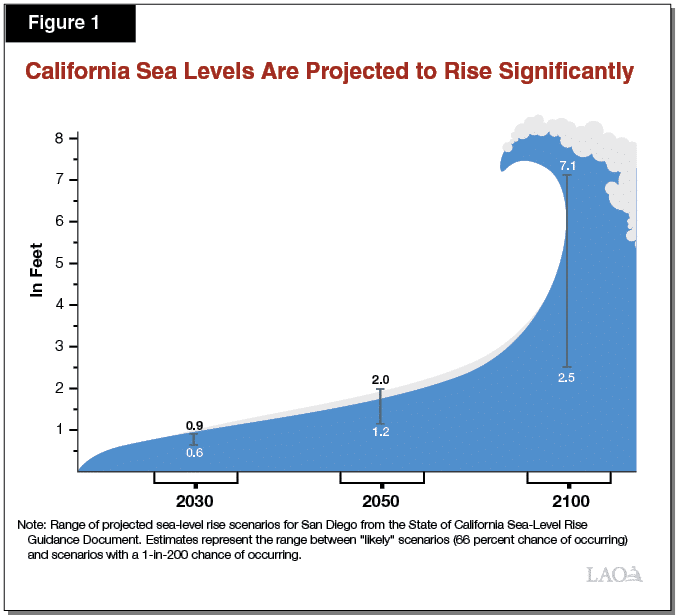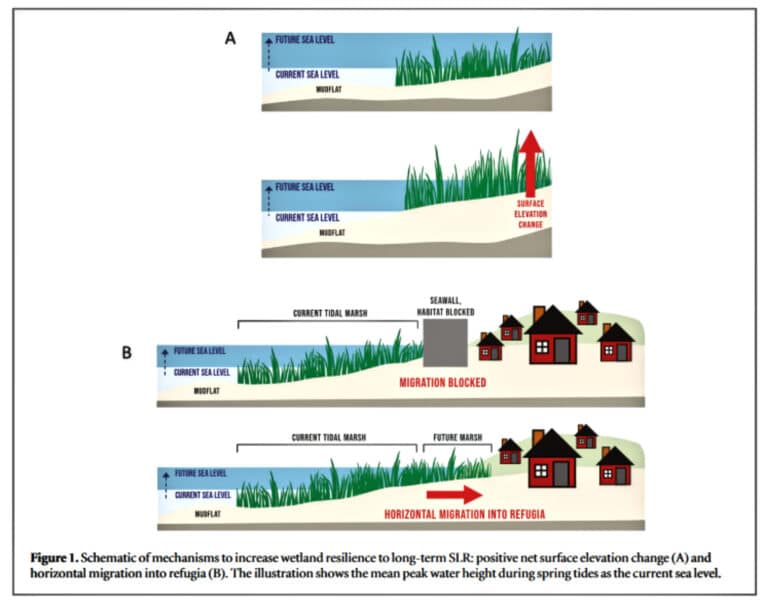Sea Level Rise and the Threat to the Bay's Wetlands and Wildlife

One of the biggest threats to the Bay today is climate change and sea level rise.
Due to rising global temperatures as a result of climate change, which is causing the melting of the world’s glaciers and ice sheets, as well as thermal expansion of sea water, scientists are predicting the Bay will rise between 0.6 feet and 0.9 feet by 2030, and between 2.5 to 7.1 feet by 2100. The rise of water levels in the Bay – both sea levels and groundwater levels – will have enormous impacts on the San Francisco Bay ecosystem as well as the broader built environment of the Bay Area.
As a natural system, tidal wetlands and other habitat types are dynamic ecosystems that have natural methods for adapting to fluctuating environmental conditions. Tidal wetlands have two natural methods for responding to sea level rise: First, they can grow vertically (accretion) through the capture of sediment and growth of vegetation. Second, they can migrate landward where shoreline slopes permit. These processes are depicted in the figure to the right from a 2022 Climate Central paper, “Vulnerability and Resilience of U.S. Coastal Wetlands to Accelerating Sea Level Rise.”

However, in the highly urbanized San Francisco Bay Area, the Bay’s wetlands face major challenges to their natural adaptation to rising sea levels.
First, development up to the very edges of the Bay have seriously compromised the natural resilience of wetlands, as the former open space areas where wetlands might migrate are no longer available. All it takes is a look at a Google Earth image of the South Bay and it will quickly become evident that as sea levels continue to rise there are very few places remaining where it is possible for tidal wetlands to migrate landward. And sadly, unlike wetlands, which are protected by regulatory agencies such as the San Francisco Bay Conservation and Development Commission, upland areas and wetland migration zones have yet to gain the same level of protections.
Second, traditional flood control protection such as levees and seawalls restrict the ability of Bay habitats to respond to sea level rise, by similarly blocking these migration corridors.
Third, so many of the creeks and rivers that flow into the Bay have been dammed and engineered into culverts, significantly reducing the amount of sediment that would otherwise reach the Bay and be available for our wetlands to keep pace with sea level rise. A recent San Francisco Estuary Institute (SFEI) publication, “Sediment for Survival,” makes it clear that without access to sediment supplies and/or options to migrate landward, much of the Bay Area’s wetlands risk drowning as sea levels rise.
We Need to Act Now to Protect the Future Health of the Bay and Our Communities.
However, despite the challenges, there is still hope. The Bay’s scientific community makes it clear that through our actions today, we can ensure a future for the Bay’s wetlands.
Most importantly, we can work together to permanently protect our remaining undeveloped baylands, and additional wetland migration areas throughout the Bay, particularly the thousands of acres that CCCR is focused on as we seek to Complete the Refuge. Scientists are also thoughtfully planning wetland restoration projects to incorporate varying elevations to respond to sea level rise. Additionally, we can transport sediment to support the growth of wetlands, and pursue other innovative ideas such as removing dams that are no longer needed and restoring historic creek-Bay connections that return sediment flows into the Bay and produce “mini deltas” that can withstand even some of the highest sea level rise projections.
We are fortunate to have many of the world’s best scientists working on these issues in San Francisco Bay right now. However, we have learned in our five decades of activism that a good idea doesn’t implement itself. Right now, as the region prepares for sea level rise, it is critical that decision-makers follow the guidance of scientists and prioritize the health and resilience of the Bay ecosystem in addition to protecting the built environment. The future of our Bay depends on it!
Make sure to Join our Newsletter to be informed of opportunities to support a resilient Bay.